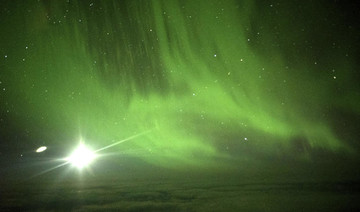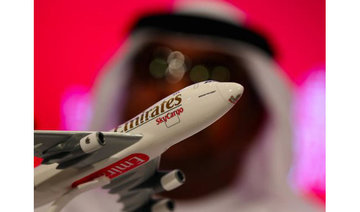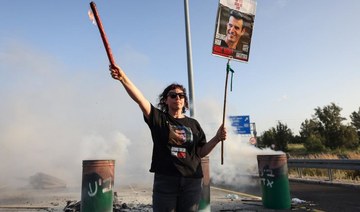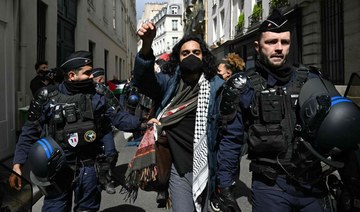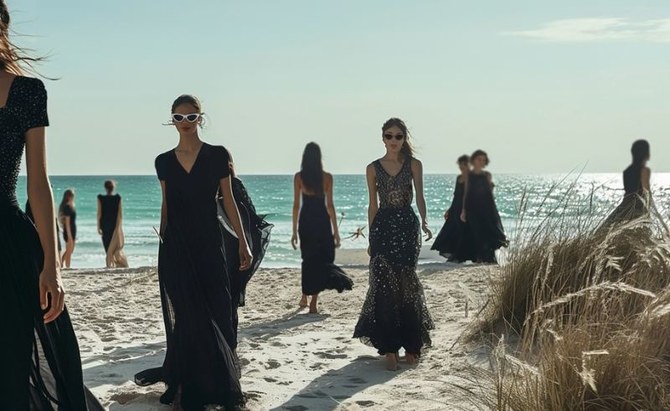CHICAGO: Video of police officers dragging a passenger from an overbooked United Airlines flight sparked an uproar Monday on social media, and a spokesman for the airline insisted that employees had no choice but to contact authorities to remove the man.
As the flight waited to depart from Chicago’s O’Hare Airport, officers could be seen grabbing the screaming man from a window seat, pulling him across the armrest and dragging him down the aisle by his arms. The airline was trying to make room for four of its employees on the Sunday evening flight to Louisville, Kentucky.
Other passengers on Flight 3411 are heard saying, “Please, my God,” “What are you doing?” “This is wrong,” “Look at what you did to him” and “Busted his lip.”
Passenger Audra D. Bridges posted the video on Facebook. Her husband, Tyler Bridges, said United offered $400 and then $800 vouchers and a hotel stay for volunteers to give up their seats. When no one volunteered, a United manager came on the plane and announced that passengers would be chosen at random.
“We almost felt like we were being taken hostage,” Tyler Bridges said. “We were stuck there. You can’t do anything as a traveler. You’re relying on the airline.”
When airline employees named four customers who had to leave the plane, three of them did so. The fourth person refused to move, and police were called, United spokesman Charlie Hobart said.
“We followed the right procedures,” Hobart told the Associated Press in a phone interview. “That plane had to depart. We wanted to get our customers to their destinations.”
Oscar Munoz, CEO of United Airlines’ parent company, described the event as “upsetting” and apologized for “having to re-accommodate these customers.” He said the airline was conducting a review and reaching out to the passenger to “further address and resolve this situation.”
The passenger told the manager that he was a doctor who needed to see patients in the morning, Bridges said.
“He was kind of saying that he was being singled out because he’s a Chinese man” when speaking to the manager, who was African-American, Bridges said.
“You should know what this is like,” the man said, according to Bridges.
The AP was unable to confirm the passenger’s identity or ethnicity.
@United overbook #flight3411 and decided to force random passengers off the plane. Here's how they did it: pic.twitter.com/QfefM8X2cW
— Jayse D. Anspach (@JayseDavid) April 10, 2017
Two officers tried to reason with the man before a third came aboard and pointed at the man “basically saying, ‘Sir, you have to get off the plane,’” Bridges said. That’s when the altercation happened.
The four United employees then boarded the plane.
“People on the plane were letting them have it,” he said. “They were saying you should be ashamed to work for this company.”
A few minutes later, the man who was removed from the plane returned, looking dazed and saying he had to get home, Bridges said. Officers followed him to the back of the plane. Another man traveling with high school students stood up at that point and said they were getting off the plane, Bridges said.
About half of the passengers followed before United told everyone to get off, he said.
@united @CNN @FoxNews @WHAS11 Man forcibly removed from plane somehow gets back on still bloody from being removed pic.twitter.com/njS3nC0pDl
— Tyler Bridges (@Tyler_Bridges) April 10, 2017
The man who was originally dragged down the aisle was removed from the plane again, and United employees made an announcement saying they had to “tidy up” the aircraft, Bridges said.
Bridges’ wife told him she saw the man taken away on a stretcher, he said.
After a three-hour delay the flight took off without the man aboard, Bridges said. A United employee apologized to passengers, he said.
Airlines are allowed to sell more tickets than there are seats on the plane, and they routinely overbook flights because some people do not show up.
It’s not unusual for airlines to offer travel vouchers to encourage people to give up their seats, and there are no rules for the process. When an airline demands that a passenger give up a seat, the airline is required to pay compensation of double the passenger’s fare, up to $675, if the passenger can be placed on another flight that arrives one to two hours later than the first flight, or four times the ticket price, up to $1,350, for longer delays.
When they bump passengers, airlines are required to give those passengers a written description of their compensation rights.
Hobart declined to say how the airline compensated the passengers who were forced to leave the plane, saying he did not have those details from employees on the scene.
Last year, United forced 3,765 people off oversold flights and another 62,895 United passengers volunteered to give up their seats, probably in exchange for travel vouchers.
That’s out of more than 86 million people who boarded a United flight in 2016, according to government figures. United ranks in the middle of US carriers when it comes to bumping passengers.
ExpressJet, which operates flights under the United Express, American Eagle and Delta Connection names, had the highest rate of bumping passengers last year. Among the largest carriers, Southwest Airlines had the highest rate, followed by JetBlue Airways.
Bridges said United should not have boarded the flight if it was overbooked.
“The man handled it wrong,” he said. “The police were kind of put in a bad spot. There’s a lot of ways United could have handled it, and that was not one of the good ways.”



